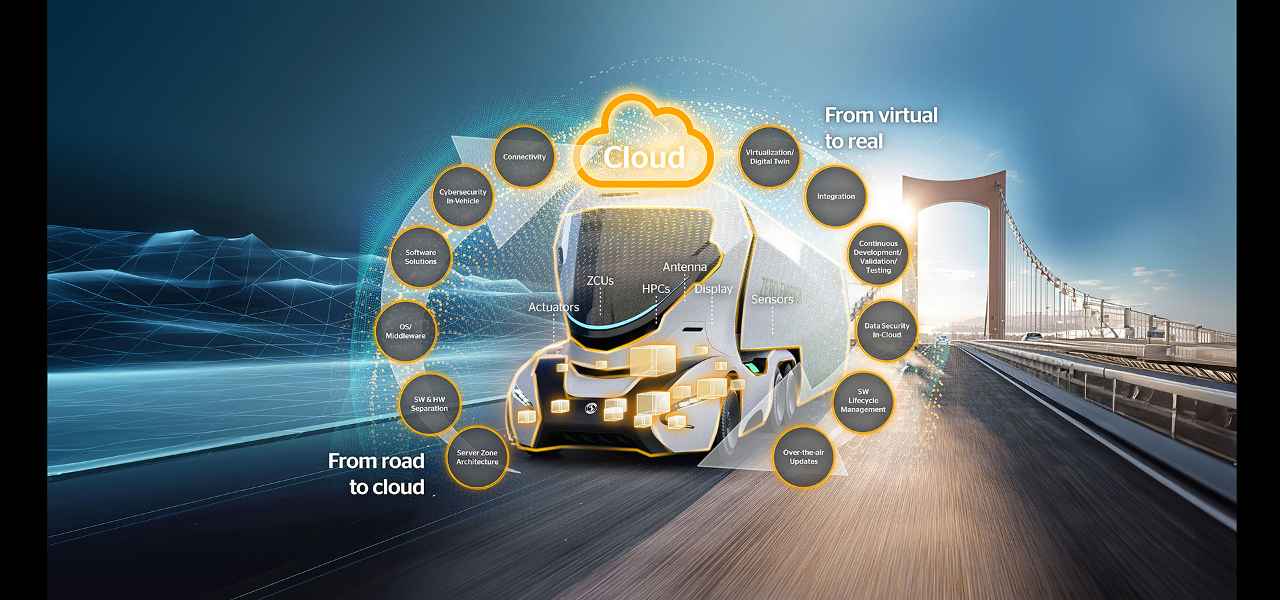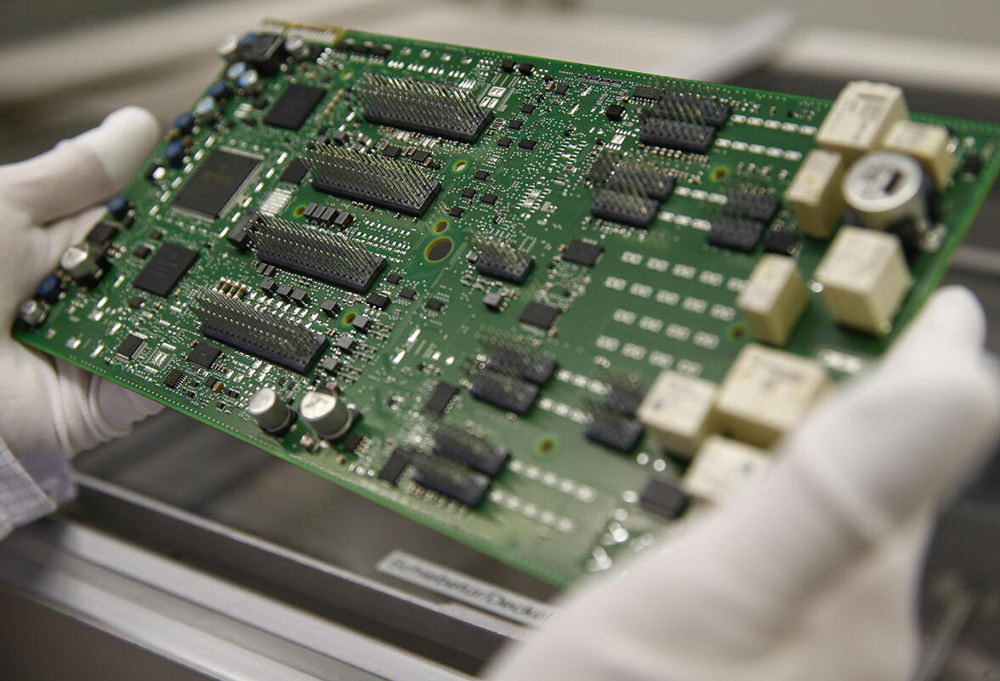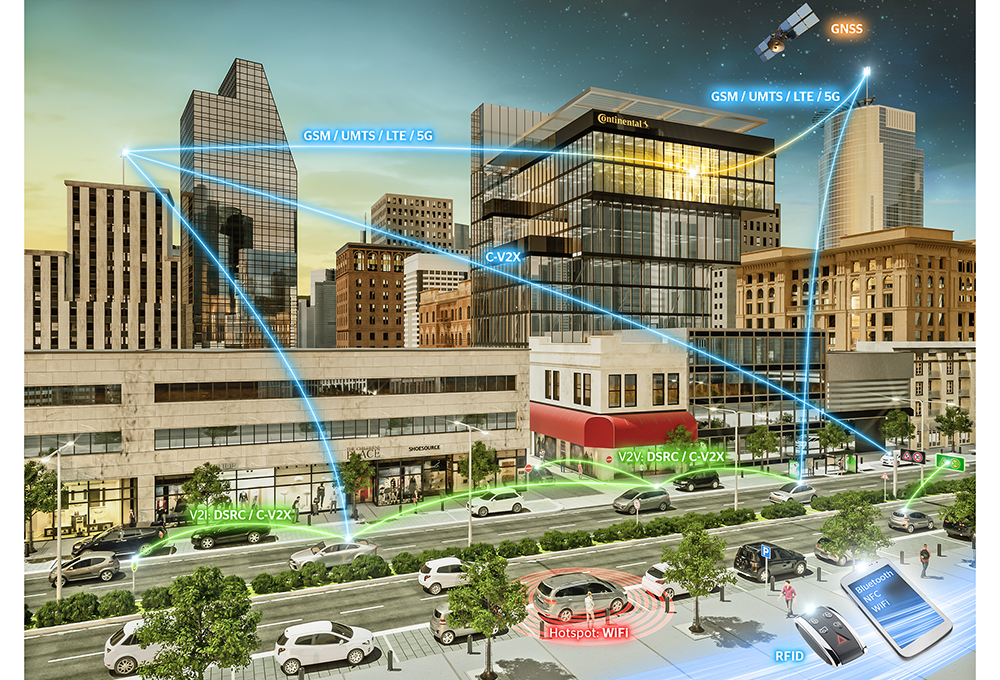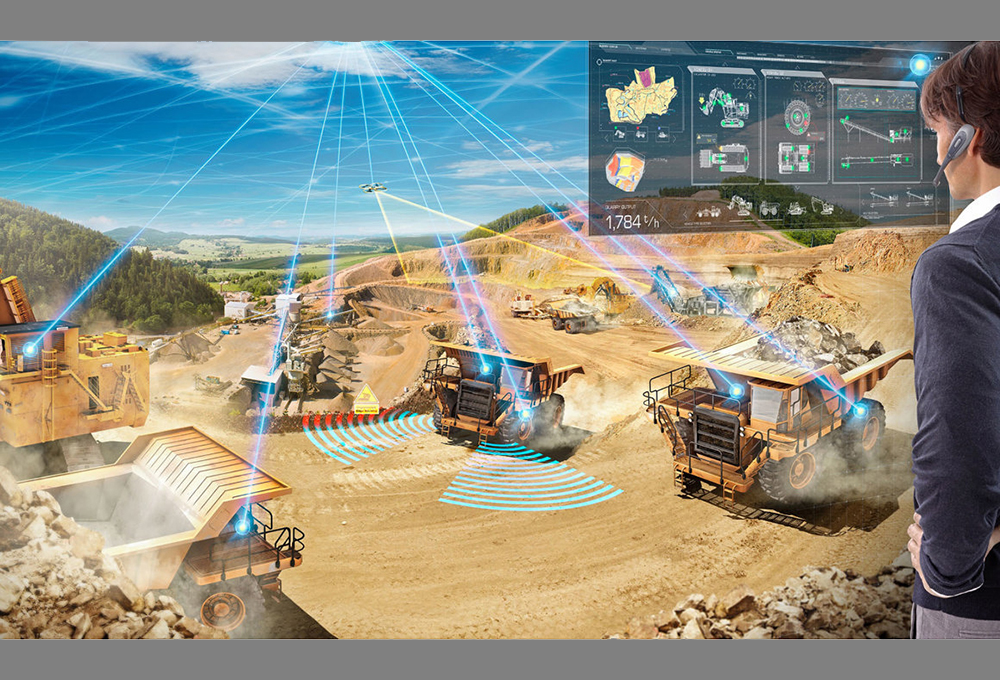 数据处理和无缝连接技术将在未来商用车的发展中占据核心地位,这就需要使用软件来管理车辆与云端之间频繁的数据交换。(大陆集团)
数据处理和无缝连接技术将在未来商用车的发展中占据核心地位,这就需要使用软件来管理车辆与云端之间频繁的数据交换。(大陆集团) 大陆集团商用车与特种车辆业务负责人Georg Fässler是SAE COMVEC 2024(商用车工程年会)的执行主席。(大陆集团)
大陆集团商用车与特种车辆业务负责人Georg Fässler是SAE COMVEC 2024(商用车工程年会)的执行主席。(大陆集团) 自动驾驶要求车辆的计算能力呈指数级增长。(大陆集团)
自动驾驶要求车辆的计算能力呈指数级增长。(大陆集团) 车辆与其环境之间的数据传输会带来风险,这就要求公司开发出从最初开发到整个产品生命周期都包含网络安全的解决方案。(大陆集团)
车辆与其环境之间的数据传输会带来风险,这就要求公司开发出从最初开发到整个产品生命周期都包含网络安全的解决方案。(大陆集团) 与Aurora合作开发即将推出的SAE L4自动驾驶系统的经验和技术也将使大陆集团的乘用车客户受益。(大陆集团)
与Aurora合作开发即将推出的SAE L4自动驾驶系统的经验和技术也将使大陆集团的乘用车客户受益。(大陆集团) 完全透明的数据是建筑和采矿等非公路行业提高生产率的关键。(大陆集团)
完全透明的数据是建筑和采矿等非公路行业提高生产率的关键。(大陆集团)
大陆集团Georg Fässler是SAE COMVEC 2024(商用车工程年会)的执行主席,他详细介绍了大陆集团为打造未来汽车做出的各项工作。
驾驶员严重短缺、燃料和材料成本上升、货运需求不断攀升、可持续发展要求日趋严格——运输业面临的挑战不可谓不严峻。商用车制造商和行业供应商正积极投入大量资源,开发、测试和向市场推出有助于缓解这些压力的先进技术。
大陆汽车(Continental Automotive)商用车与特种车辆业务负责人Georg Fässler近期在接受SAE采访时表示:“在我看来,实现商用车和全物流链的数字化是应对这些问题的必要手段,也是商用车行业最重要的发展趋势之一。”
作为今年9月10~12日举行的SAE COMVEC 2024的主办方,大陆集团将大会主题定为“智能机器与机器数字化”并非巧合。作为大会执行主席,Fässler将为期三天的COMVEC 2024称为业界公开探讨最新发展趋势和挑战“最重要的科学交流与沟通平台”。鉴于出行领域的技术变革日新月异,届时会上将不乏可供探讨的话题。
大陆集团和其他行业参与者已在实现软件定义商用车方面取得了重大进展。Fässler 称:“我们已成功实现了软硬件解耦,同时提供了可靠的中间件。”随着这些车辆逐渐接入物联网(IoT),软件将负责处理、管理和分发与云端交换的大量实时数据。
这些技术进步也将改变汽车内部结构。Fässler强调:“自动驾驶技术尤其要求车辆具备呈指数级增长的算力,以便安全、稳定、快速地处理海量的数据。这种趋势将导致车辆结构向整合电气电子系统和软件的集中架构转变,并利用更强大的计算单元处理数据。因此,网络安全的重要性也与日俱增。
Fässler强调:“各汽车制造商必须重视保护关键资产和防范潜在事故,根据其特定的需求制定网络安全策略,具体包括提供涵盖产品全生命周期(从设计到报废)的网络安全维护合同。”
大陆集团从多个角度解决了网络安全问题,包括在组件层面上将每个电子组件用作履行特定职责的“迷你计算机”,以及在系统层面上确保整个车辆系统内的安全通信。此外,大陆十分重视保护车辆与外界进行交互的各种外部接口,对于在车辆外部(包括云和后端系统)传输和处理的数据也给予了同等保护。
他表示:“公众对完全无人驾驶的商用车仍普遍存在迟疑。但COMVEC年会等活动提供了展示技术进步的机会,充分展现了自动驾驶系统的稳定性和安全性,并向公众介绍这些技术在安全性方面胜过人类驾驶员的优势。”
Fässler表示:“这是一项已具备实现商业化条件的开创性技术,如此复杂的系统解决方案自然也会在法律和研发层面上面临各种挑战。毫无疑问,市场上没有任何一方能够独立应对这些问题。”
他表示:“在这方面,大陆的L4级自动驾驶解决方案及与Aurora的合作成果是开创性的。”
本专题报道由SAE官方会员专享杂志《Update》编辑Gretchen Uhrinek撰写。
Severe driver shortages, rising fuel and material costs, escalating demand for freight transport, higher sustainability requirements – there is no shortage of challenges facing the transport sector. Commercial vehicle manufacturers and industry suppliers are devoting significant resources to develop, test and bring to market the technological advances that will help alleviate these pressure points.
“The digitalization of commercial vehicles and the whole logistics chain is a necessary response and one of the most important developments in the CV industry in my view,” said Continental Automotive’s head of commercial and special vehicles, Georg Fässler, in a recent interview with SAE International.
It’s no coincidence that Continental, as the executive host for SAE’s 2024 COMVEC event from September 10-12, set a theme centered around “Smart Machines. The Digitalization of Machines.” Fässler, in his role as COMVEC executive chair, described the three-day conference as “the most important scientific exchange place, communication place,” where industry can openly discuss its latest trends and challenges. With mobility’s rapidly shifting technological landscape, there will be plenty to talk about.
“There were never [as] many changes in the commercial vehicle industry than in the last ten years,” Fässler said. “And probably even more coming in the next ten years.” Future commercial vehicles will be “permanently and seamlessly connected,” he predicted, which will enable new functions both within and outside of the vehicle, increasing safety, efficiency and comfort for the driver.
A software-defined future
Fässler, who holds a Ph.D. in electromagnetic computation methods, launched his career by working on cell phones – “pretty small devices, opposite to trucks,” he said with a chuckle. But actually, he pointed out, the software isn’t all that different.
Much like cell phones, modern commercial vehicles heavily rely on integrated software for seamless functionality. “Integrating digital solutions and connectivity technologies is key to making commercial vehicles future-proof,” he said.
Fässler pointed to the development of software-defined and autonomous commercial vehicles as the industry’s most exciting innovation today. How to effectively achieve a “software-defined future” will be core to the SAE COMVEC agenda.
“Just as passenger cars, commercial vehicles will increasingly rely on software-enabled functions, with software being decoupled from hardware for rapid development and over-the-air (OTA) updates – particularly with the emergence of modern driver-assistance systems and the eventual transition to automated and fully autonomous driving,” he said.
Continental and other industry players already have made significant strides toward realizing software-defined commercial vehicles. “We’ve succeeded in decoupling hardware from software while offering reliable middleware,” Fässler asserted. As these vehicles increasingly become part of the Internet of Things (IoT), software will be tasked with processing, managing and distributing the influx of real-time data to and from the cloud.
These advances also will reshape the vehicle’s internal structure. “Automated driving, in particular, will require an exponential increase in a vehicle’s computing power, demanding to process the data flood securely, reliably and quickly,” Fässler said. “This results in a shift towards a centralized vehicle architecture (E/E and software) with more powerful computing units and consequently ever-growing significance of cybersecurity.”
Cybersecurity strategies
Cybersecurity becomes a greater concern as software and connectivity increase. Data transfer between the vehicle and its environment introduces risks. To protect against potential threats, companies need to develop end-to-end solutions that incorporate cybersecurity from initial development through the entire product lifecycle, Fässler advised.
“At Continental, we have developed a Cybersecurity Management System (CSMS) compliant with ISO/SAE 21434, tailored to the needs of commercial vehicles,” he said. “This system is adaptable and ensures a structured approach to cybersecurity.”
Continental also “actively participates” in the ongoing development and extension of ISO/SAE 21434, as well as efforts related to the development of standards for the agriculture and off-highway sectors (ISO 24882).
“By focusing on protecting critical assets and preparing for potential incidents, cybersecurity strategies need to be tailored to the specific needs of vehicle manufacturers,” he said. “This approach includes offering cybersecurity maintenance contracts that cover the entire product lifecycle, from design to end-of-life.”
In addition to enabling remote upgrades, bug fixes and the implementation of new features, OTA updates also can ensure top-tier security throughout the vehicle lifecycle, Fässler noted.
Continental’s approach addresses cybersecurity from multiple angles. This includes at the component level, with each electronic component functioning as a “mini-computer” with specific responsibilities, and at the system level, ensuring secure communication within the vehicle’s entire system. Securing the various external interfaces between the vehicle and the outside world also is critical, as is protecting data during transfer and processing outside the vehicle, including cloud and backend systems.
Autonomous endgame
The ultimate goal is achieving full autonomy in commercial vehicles, Fässler said. However, the public’s unease towards this technology is no secret. Fässler believes in directly addressing uncertainty regarding automation to help mitigate concerns and build confidence.
“Public hesitation about completely driverless commercial vehicles is still common,” he said. “Events like COMVEC offer opportunities to showcase advancements, demonstrate the reliability and safety of autonomous systems, and communicate how these technologies can outperform human drivers in terms of safety.”
Continental and Aurora Innovation announced at CES 2024 in Las Vegas that they had finalized their design of a scalable SAE Level 4 automated driving system, the Aurora Driver. Start of production is expected in 2027.
“This is groundbreaking technology that is scaled up to a commercial-attractive level, which naturally entails challenges – on the legal side as well as in development of such a complex system solution,” Fässler said. “Fully clear is that no player in the market can overcome these challenges [on] its own.”
Fässler said that components and base technologies developed for the high-volume passenger vehicle market can significantly reduce costs and development time for its customers in other markets, including commercial vehicle and off-highway. However, autonomy is one area in which lessons learned and technologies developed specifically for heavy-duty vehicles can be transferred to benefit passenger cars.
“Here, particularly our L4 autonomous driving solutions and cooperation with Aurora serve as pioneers,” he said.
Slashing CO2
Alleviating autonomous anxiety isn’t the only task at hand. As climate change becomes harder to ignore, the transportation sector is under mounting pressure to improve its sustainability, and fast.
“There’s a significant shift toward electric commercial vehicles driven by environmental concerns and government regulations,” Fässler said. “And society is supporting the move towards slashing CO2 emissions.”
To get there, charging infrastructure needs to improve – both for passenger and commercial vehicles. According to Fässler, this means more high-powered fast charging stations strategically placed along major routes and at key hubs, further standardization, and grid upgrades.
“Standardizing the charging system is essential to ensure compatibility across different vehicle makes and models,” he said.
Vehicle range and the high costs of transitioning to a fully electric fleet are also considerable challenges that need to be addressed. Fässler indicated that governments and industry can, and should, work together to meet the public’s demand for positive change.
“Governments can play a significant role in accelerating the adoption of electric commercial vehicles through incentives such as subsidies, tax breaks, and grants for vehicle purchases and charging infrastructure installation,” he said. “Additionally, regulations such as emissions standards and zero-emission zones can incentivize fleet operators to switch to electric vehicles.”
One such regulation is the U.S. EPA’s recent final rule on greenhouse gas (GHG) emissions standards for heavy-duty vehicles. These “Phase 3” guidelines establish new CO2 emissions for model year 2032 and later heavy-duty vehicles, beginning as early as MY 2027 for certain vehicle categories. For example, MY 2027 light-heavy vocational vehicles must cut CO2 emissions by 17% compared to the Phase 2 regulations; by MY 2032, that figure swells to 60%.
“As the climate crisis intensifies, regulations that affect commercial vehicles will continue to increase, as they will in all sectors,” Fässler said.
Gretchen Uhrinek, the editor for SAE’s official member magazine, Update, contributed to this feature story.
等级
打分
- 2分
- 4分
- 6分
- 8分
- 10分
平均分
